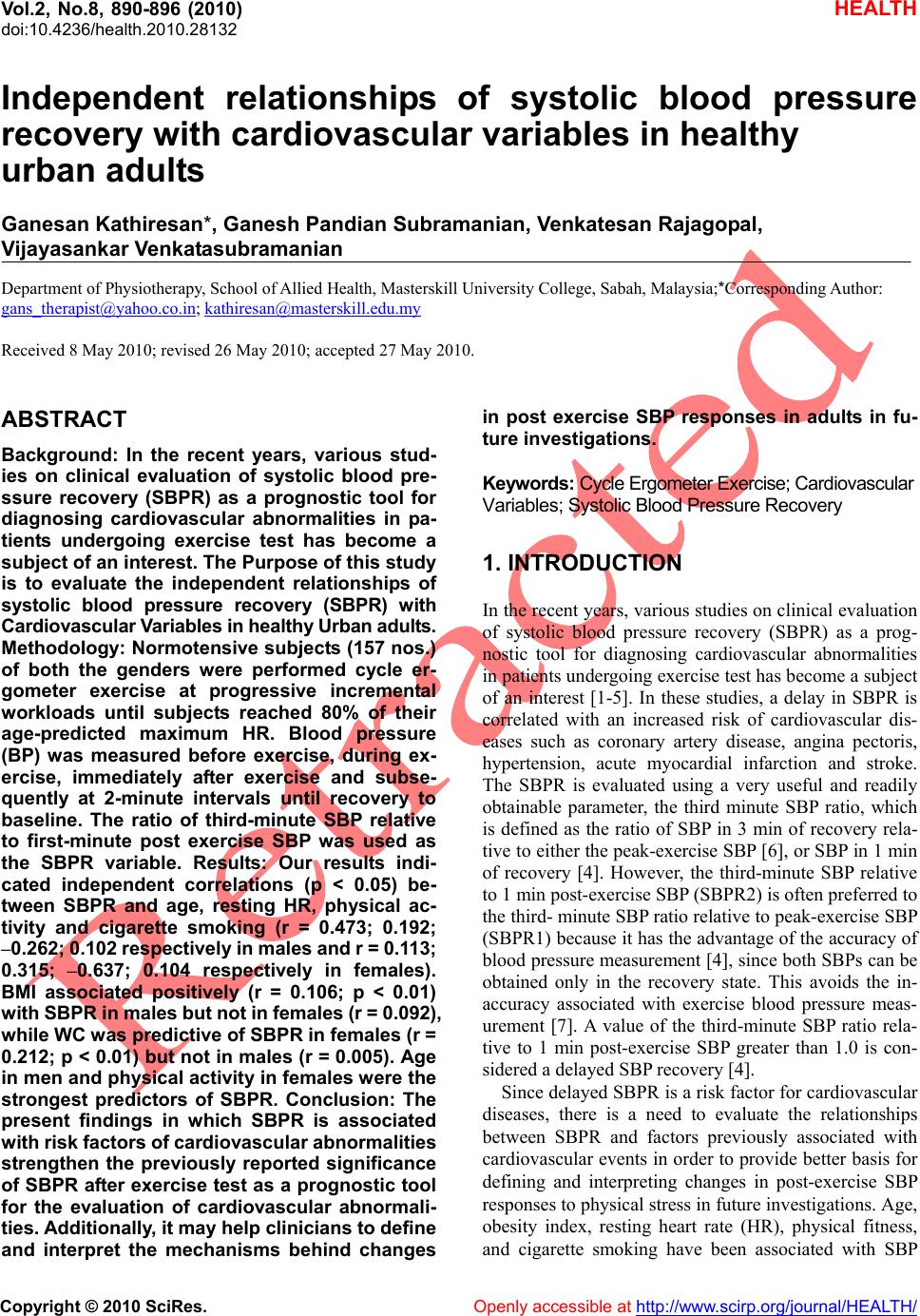 Vol.2, No.8, 890-896 (2010) doi:10.4236/health.2010.28132 Copyright © 2010 SciRes. Openly accessible at http://www.scirp.org/journal/HEALTH/ HEALTH Independent relationships of systolic blood pressure recovery with cardiovascular variables in healthy urban adults Ganesan Kathiresan*, Ganesh Pandian Subramanian, Venkatesan Rajagopal, Vijayasankar Venkatasubramanian Department of Physiotherapy, School of Allied Health, Masterskill University College, Sabah, Malaysia;*Corresponding Author: gans_therapist@yahoo.co.in; kathiresan@masterskill.edu.my Received 8 May 2010; revised 26 May 2010; accepted 27 May 2010. ABSTRACT Background: In the recent years, various stud- ies on clinical evaluation of systolic blood pre- ssure recovery (SBPR) as a prognostic tool for diagnosing cardiovascular abnormalities in pa- tients undergoing exercise test has become a subject of an interest. The Purpose of this study is to evaluate the independent relationships of systolic blood pressure recovery (SBPR) with Cardiovascular Variables in healthy Urban adults. Methodology: Normotensive subjects (157 nos.) of both the genders were performed cycle er- gometer exercise at progressive incremental workloads until subjects reached 80% of their age-predicted maximum HR. Blood pressure (BP) was measured before exercise, during ex- ercise, immediately after exercise and subse- quently at 2-minute intervals until recovery to baseline. The ratio of third-minute SBP relative to first-minute post exercise SBP was used as the SBPR variable. Results: Our results indi- cated independent correlations (p < 0.05) be- tween SBPR and age, resting HR, physical ac- tivity and cigarette smoking (r = 0.473; 0.192; –0.262; 0.102 respectively in males and r = 0.113; 0.315; –0.637; 0.104 respectively in females). BMI associated positively (r = 0.106; p < 0.01) with SBPR in males but not in females (r = 0.092), while WC was predictive of SBPR in females (r = 0.212; p < 0.01) but not in males (r = 0.005). Age in men and physical activity in females were the strongest predictors of SBPR. Conclusion: The present findings in which SBPR is associated with risk factors of cardiovascular abnormalities strengthen the previously reported significance of SBPR after exercise test as a prognostic tool for the evaluation of cardiovascular abnormali- ties. Additionally, it may help clinicians to define and interpret the mechanisms behind changes in post exercise SBP responses in adults in fu- ture investigations. Keywords: Cycle Ergometer Exercise; Cardiovascular Variables; Systolic Blood Pressure Recovery 1. INTRODUCTION In the recent years, various studies on clinical evaluation of systolic blood pressure recovery (SBPR) as a prog- nostic tool for diagnosing cardiovascular abnormalities in patients undergoing exercise test has become a subject of an interest [1-5]. In these studies, a delay in SBPR is correlated with an increased risk of cardiovascular dis- eases such as coronary artery disease, angina pectoris, hypertension, acute myocardial infarction and stroke. The SBPR is evaluated using a very useful and readily obtainable parameter, the third minute SBP ratio, which is defined as the ratio of SBP in 3 min of recovery rela- tive to either the peak-exercise SBP [6], or SBP in 1 min of recovery [4]. However, the third-minute SBP relative to 1 min post-exercise SBP (SBPR2) is often preferred to the third- minute SBP ratio relative to peak-exercise SBP (SBPR1) because it has the advantage of the accuracy of blood pressure measurement [4], since both SBPs can be obtained only in the recovery state. This avoids the in- accuracy associated with exercise blood pressure meas- urement [7]. A value of the third-minute SBP ratio rela- tive to 1 min post-exercise SBP greater than 1.0 is con- sidered a delayed SBP recovery [4]. Since delayed SBPR is a risk factor for cardiovascular diseases, there is a need to evaluate the relationships between SBPR and factors previously associated with cardiovascular events in order to provide better basis for defining and interpreting changes in post-exercise SBP responses to physical stress in future investigations. Age, obesity index, resting heart rate (HR), physical fitness, and cigarette smoking have been associated with SBP 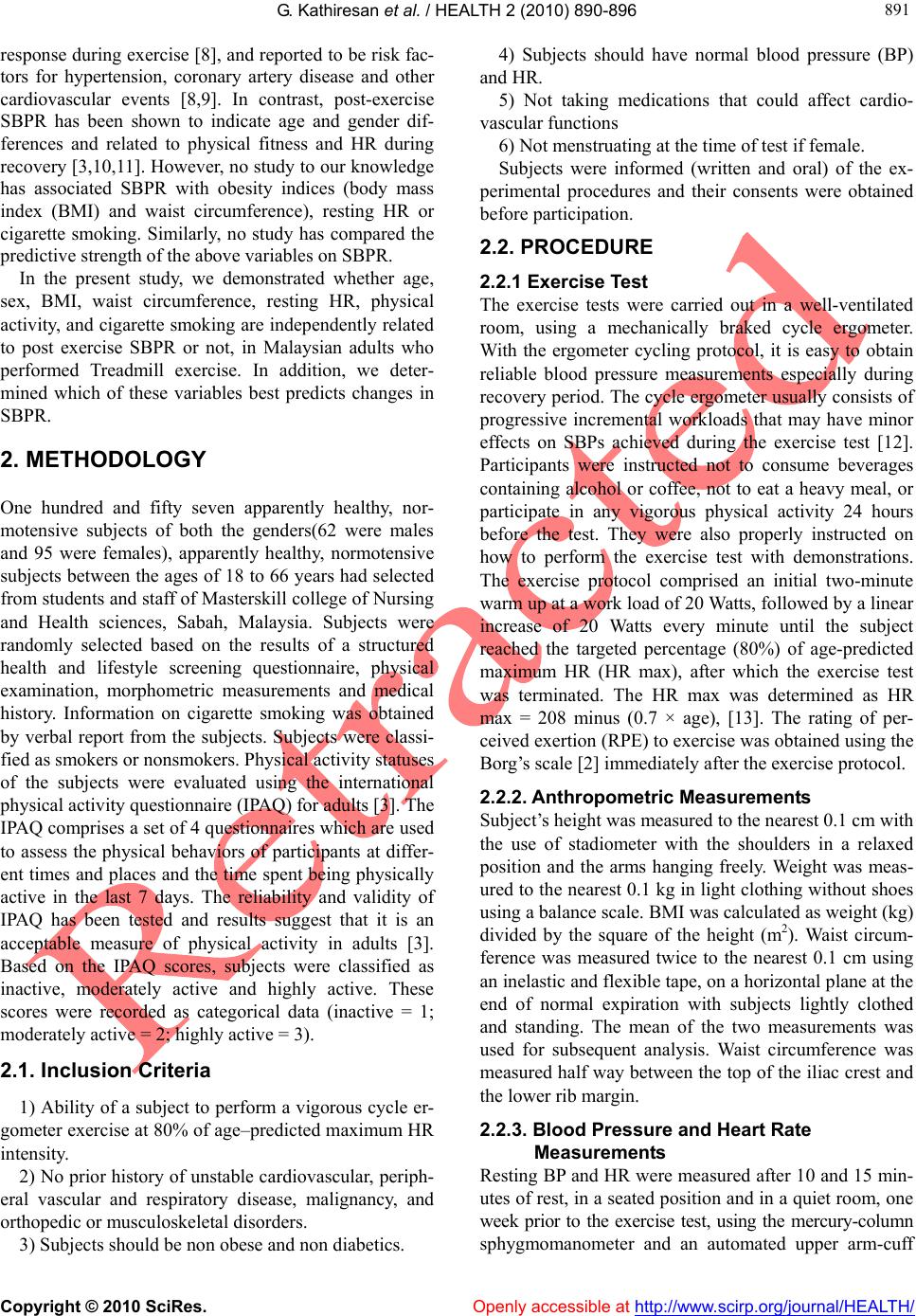 G. Kathiresan et al. / HEALTH 2 (2010) 890-896 Copyright © 2010 SciRes. Openly accessible at http://www.scirp.org/journal/HEALTH/ 891 891 response during exercise [8], and reported to be risk fac- tors for hypertension, coronary artery disease and other cardiovascular events [8,9]. In contrast, post-exercise SBPR has been shown to indicate age and gender dif- ferences and related to physical fitness and HR during recovery [3,10,11]. However, no study to our knowledge has associated SBPR with obesity indices (body mass index (BMI) and waist circumference), resting HR or cigarette smoking. Similarly, no study has compared the predictive strength of the above variables on SBPR. In the present study, we demonstrated whether age, sex, BMI, waist circumference, resting HR, physical activity, and cigarette smoking are independently related to post exercise SBPR or not, in Malaysian adults who performed Treadmill exercise. In addition, we deter- mined which of these variables best predicts changes in SBPR. 2. METHODOLOGY One hundred and fifty seven apparently healthy, nor- motensive subjects of both the genders(62 were males and 95 were females), apparently healthy, normotensive subjects between the ages of 18 to 66 years had selected from students and staff of Masterskill college of Nursing and Health sciences, Sabah, Malaysia. Subjects were randomly selected based on the results of a structured health and lifestyle screening questionnaire, physical examination, morphometric measurements and medical history. Information on cigarette smoking was obtained by verbal report from the subjects. Subjects were classi- fied as smokers or nonsmokers. Physical activity statuses of the subjects were evaluated using the international physical activity questionnaire (IPAQ) for adults [3]. The IPAQ comprises a set of 4 questionnaires which are used to assess the physical behaviors of participants at differ- ent times and places and the time spent being physically active in the last 7 days. The reliability and validity of IPAQ has been tested and results suggest that it is an acceptable measure of physical activity in adults [3]. Based on the IPAQ scores, subjects were classified as inactive, moderately active and highly active. These scores were recorded as categorical data (inactive = 1; moderately active = 2; highly active = 3). 2.1. Inclusion Criteria 1) Ability of a subject to perform a vigorous cycle er- gometer exercise at 80% of age–predicted maximum HR intensity. 2) No prior history of unstable cardiovascular, periph- eral vascular and respiratory disease, malignancy, and orthopedic or musculoskeletal disorders. 3) Subjects should be non obese and non diabetics. 4) Subjects should have normal blood pressure (BP) and HR. 5) Not taking medications that could affect cardio- vascular functions 6) Not menstruating at the time of test if female. Subjects were informed (written and oral) of the ex- perimental procedures and their consents were obtained before participation. 2.2. PROCEDURE 2.2.1 Exercise Test The exercise tests were carried out in a well-ventilated room, using a mechanically braked cycle ergometer. With the ergometer cycling protocol, it is easy to obtain reliable blood pressure measurements especially during recovery period. The cycle ergometer usually consists of progressive incremental workloads that may have minor effects on SBPs achieved during the exercise test [12]. Participants were instructed not to consume beverages containing alcohol or coffee, not to eat a heavy meal, or participate in any vigorous physical activity 24 hours before the test. They were also properly instructed on how to perform the exercise test with demonstrations. The exercise protocol comprised an initial two-minute warm up at a work load of 20 Watts, followed by a linear increase of 20 Watts every minute until the subject reached the targeted percentage (80%) of age-predicted maximum HR (HR max), after which the exercise test was terminated. The HR max was determined as HR max = 208 minus (0.7 × age), [13]. The rating of per- ceived exertion (RPE) to exercise was obtained using the Borg’s scale [2] immediately after the exercise protocol. 2.2.2. Anthropometric Measurements Subject’s height was measured to the nearest 0.1 cm with the use of stadiometer with the shoulders in a relaxed position and the arms hanging freely. Weight was meas- ured to the nearest 0.1 kg in light clothing without shoes using a balance scale. BMI was calculated as weight (kg) divided by the square of the height (m2). Waist circum- ference was measured twice to the nearest 0.1 cm using an inelastic and flexible tape, on a horizontal plane at the end of normal expiration with subjects lightly clothed and standing. The mean of the two measurements was used for subsequent analysis. Waist circumference was measured half way between the top of the iliac crest and the lower rib margin. 2.2.3. Blood Pressure and Heart Rate Measurements Resting BP and HR were measured after 10 and 15 min- utes of rest, in a seated position and in a quiet room, one week prior to the exercise test, using the mercury-column sphygmomanometer and an automated upper arm-cuff 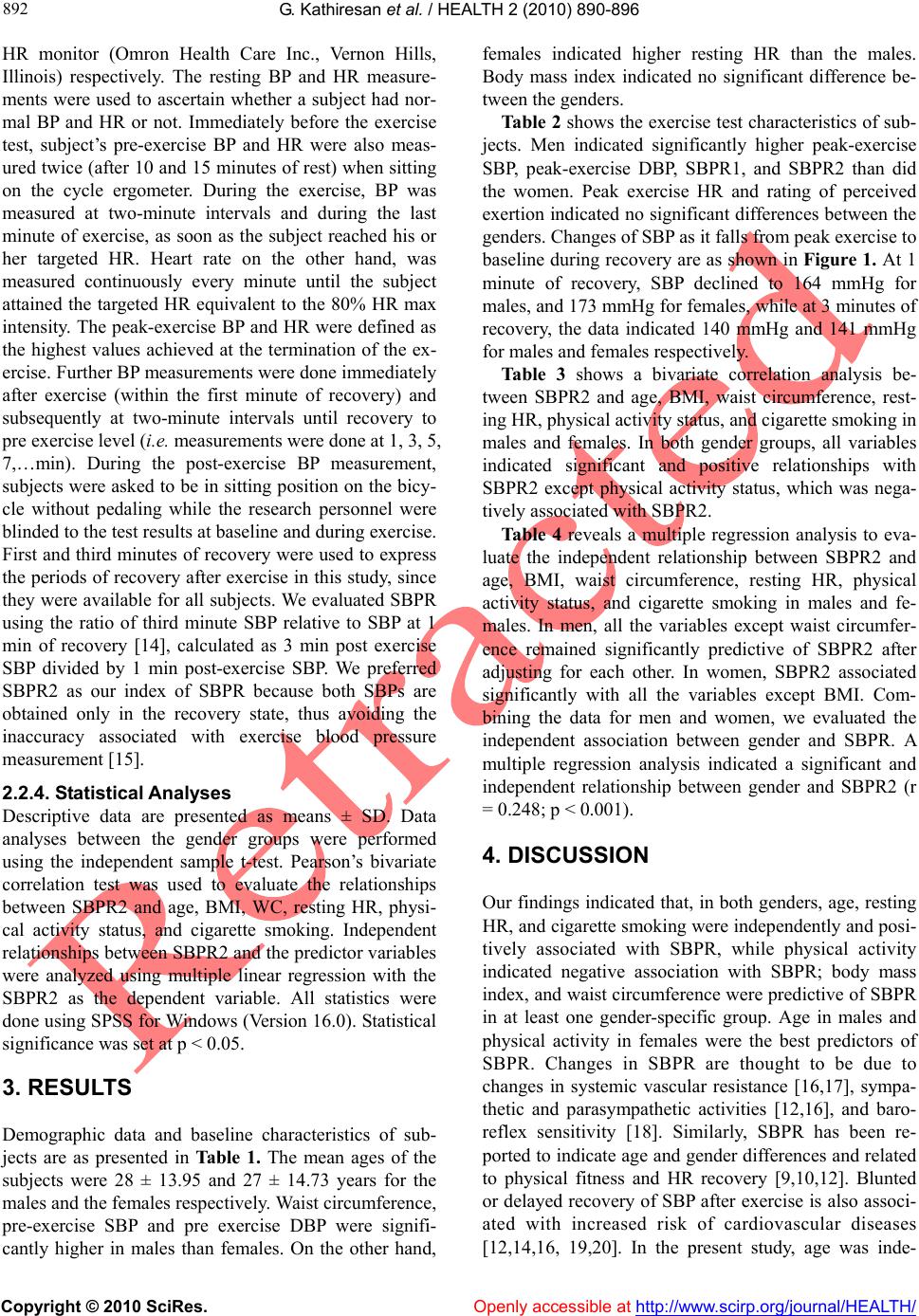 G. Kathiresan et al. / HEALTH 2 (2010) 890-896 Copyright © 2010 SciRes. Openly accessible at http://www.scirp.org/journal/HEALTH/ 892 HR monitor (Omron Health Care Inc., Vernon Hills, Illinois) respectively. The resting BP and HR measure- ments were used to ascertain whether a subject had nor- mal BP and HR or not. Immediately before the exercise test, subject’s pre-exercise BP and HR were also meas- ured twice (after 10 and 15 minutes of rest) when sitting on the cycle ergometer. During the exercise, BP was measured at two-minute intervals and during the last minute of exercise, as soon as the subject reached his or her targeted HR. Heart rate on the other hand, was measured continuously every minute until the subject attained the targeted HR equivalent to the 80% HR max intensity. The peak-exercise BP and HR were defined as the highest values achieved at the termination of the ex- ercise. Further BP measurements were done immediately after exercise (within the first minute of recovery) and subsequently at two-minute intervals until recovery to pre exercise level (i.e. measurements were done at 1, 3, 5, 7,…min). During the post-exercise BP measurement, subjects were asked to be in sitting position on the bicy- cle without pedaling while the research personnel were blinded to the test results at baseline and during exercise. First and third minutes of recovery were used to express the periods of recovery after exercise in this study, since they were available for all subjects. We evaluated SBPR using the ratio of third minute SBP relative to SBP at 1 min of recovery [14], calculated as 3 min post exercise SBP divided by 1 min post-exercise SBP. We preferred SBPR2 as our index of SBPR because both SBPs are obtained only in the recovery state, thus avoiding the inaccuracy associated with exercise blood pressure measurement [15]. 2.2.4. Statistical Analyses Descriptive data are presented as means ± SD. Data analyses between the gender groups were performed using the independent sample t-test. Pearson’s bivariate correlation test was used to evaluate the relationships between SBPR2 and age, BMI, WC, resting HR, physi- cal activity status, and cigarette smoking. Independent relationships between SBPR2 and the predictor variables were analyzed using multiple linear regression with the SBPR2 as the dependent variable. All statistics were done using SPSS for Windows (Version 16.0). Statistical significance was set at p < 0.05. 3. RESULTS Demographic data and baseline characteristics of sub- jects are as presented in Table 1. The mean ages of the subjects were 28 ± 13.95 and 27 ± 14.73 years for the males and the females respectively. Waist circumference, pre-exercise SBP and pre exercise DBP were signifi- cantly higher in males than females. On the other hand, females indicated higher resting HR than the males. Body mass index indicated no significant difference be- tween the genders. Table 2 shows the exercise test characteristics of sub- jects. Men indicated significantly higher peak-exercise SBP, peak-exercise DBP, SBPR1, and SBPR2 than did the women. Peak exercise HR and rating of perceived exertion indicated no significant differences between the genders. Changes of SBP as it falls from peak exercise to baseline during recovery are as shown in Figure 1. At 1 minute of recovery, SBP declined to 164 mmHg for males, and 173 mmHg for females, while at 3 minutes of recovery, the data indicated 140 mmHg and 141 mmHg for males and females respectively. Table 3 shows a bivariate correlation analysis be- tween SBPR2 and age, BMI, waist circumference, rest- ing HR, physical activity status, and cigarette smoking in males and females. In both gender groups, all variables indicated significant and positive relationships with SBPR2 except physical activity status, which was nega- tively associated with SBPR2. Table 4 reveals a multiple regression analysis to eva- luate the independent relationship between SBPR2 and age, BMI, waist circumference, resting HR, physical activity status, and cigarette smoking in males and fe- males. In men, all the variables except waist circumfer- ence remained significantly predictive of SBPR2 after adjusting for each other. In women, SBPR2 associated significantly with all the variables except BMI. Com- bining the data for men and women, we evaluated the independent association between gender and SBPR. A multiple regression analysis indicated a significant and independent relationship between gender and SBPR2 (r = 0.248; p < 0.001). 4. DISCUSSION Our findings indicated that, in both genders, age, resting HR, and cigarette smoking were independently and posi- tively associated with SBPR, while physical activity indicated negative association with SBPR; body mass index, and waist circumference were predictive of SBPR in at least one gender-specific group. Age in males and physical activity in females were the best predictors of SBPR. Changes in SBPR are thought to be due to changes in systemic vascular resistance [16,17], sympa- thetic and parasympathetic activities [12,16], and baro- reflex sensitivity [18]. Similarly, SBPR has been re- ported to indicate age and gender differences and related to physical fitness and HR recovery [9,10,12]. Blunted or delayed recovery of SBP after exercise is also associ- ated with increased risk of cardiovascular diseases [12,14,16, 19,20]. In the present study, age was inde- 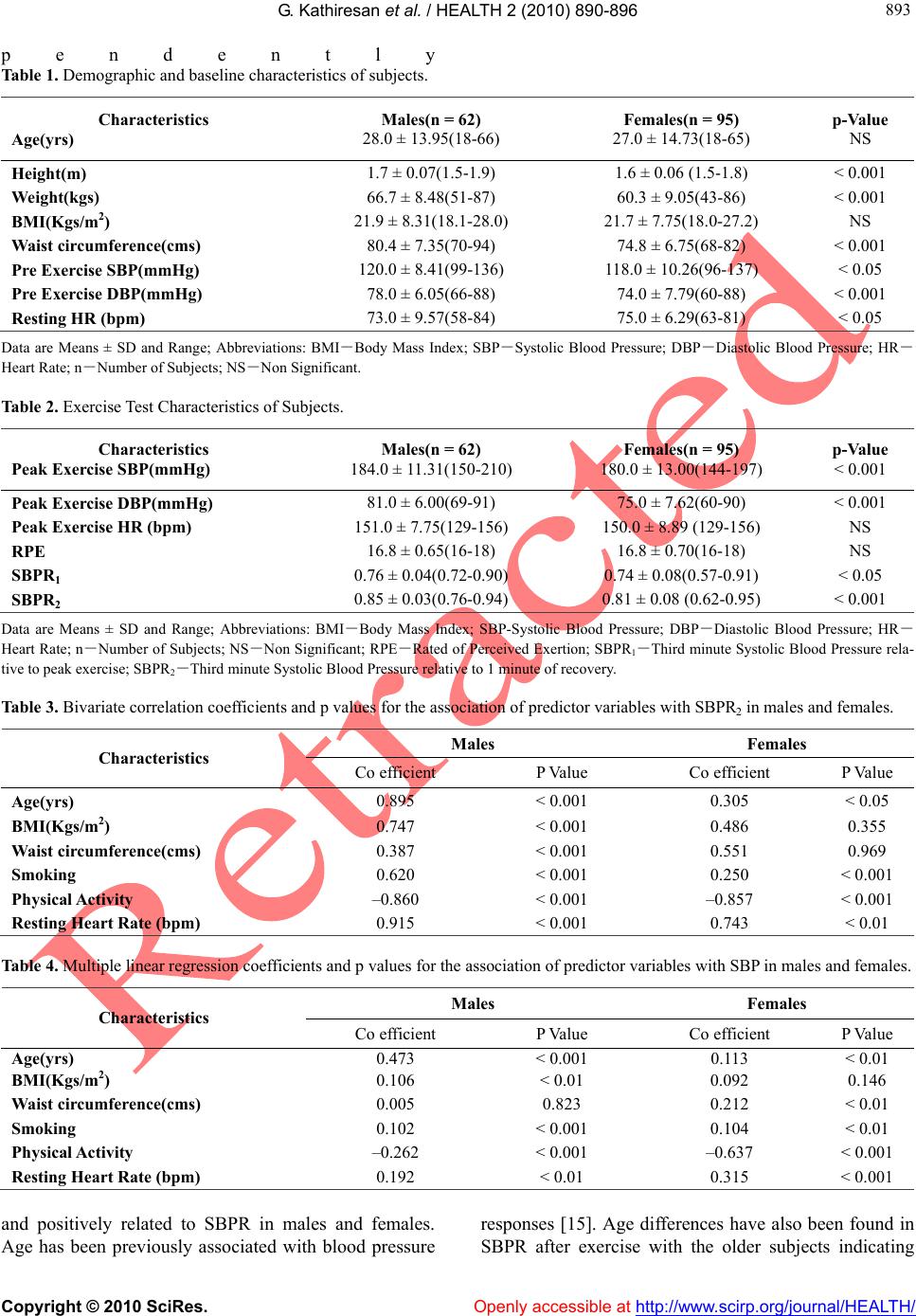 G. Kathiresan et al. / HEALTH 2 (2010) 890-896 Copyright © 2010 SciRes. http://www.scirp.org/journal/HEALTH/Openly accessible at 893 893 pendently Table 1. Demographic and baseline characteristics of subjects. Characteristics Age(yrs) Males(n = 62) 28.0 ± 13.95(18-66) Females(n = 95) 27.0 ± 14.73(18-65) p-Value NS Height(m) 1.7 ± 0.07(1.5-1.9) 1.6 ± 0.06 (1.5-1.8) < 0.001 Weight(kgs) 66.7 ± 8.48(51-87) 60.3 ± 9.05(43-86) < 0.001 BMI(Kgs/m2) 21.9 ± 8.31(18.1-28.0) 21.7 ± 7.75(18.0-27.2) NS Waist circumference(cms) 80.4 ± 7.35(70-94) 74.8 ± 6.75(68-82) < 0.001 Pre Exercise SBP(mmHg) 120.0 ± 8.41(99-136) 118.0 ± 10.26(96-137) < 0.05 Pre Exercise DBP(mmHg) 78.0 ± 6.05(66-88) 74.0 ± 7.79(60-88) < 0.001 Resting HR (bpm) 73.0 ± 9.57(58-84) 75.0 ± 6.29(63-81) < 0.05 Data are Means ± SD and Range; Abbreviations: BMI-Body Mass Index; SBP-Systolic Blood Pressure; DBP-Diastolic Blood Pressure; HR- Heart Rate; n-Number of Subjects; NS-Non Significant. Table 2. Exercise Test Characteristics of Subjects. Characteristics Peak Exercise SBP(mmHg) Males(n = 62) 184.0 ± 11.31(150-210) Females(n = 95) 180.0 ± 13.00(144-197) p-Value < 0.001 Peak Exercise DBP(mmHg) 81.0 ± 6.00(69-91) 75.0 ± 7.62(60-90) < 0.001 Peak Exercise HR (bpm) 151.0 ± 7.75(129-156) 150.0 ± 8.89 (129-156) NS RPE 16.8 ± 0.65(16-18) 16.8 ± 0.70(16-18) NS SBPR1 0.76 ± 0.04(0.72-0.90) 0.74 ± 0.08(0.57-0.91) < 0.05 SBPR2 0.85 ± 0.03(0.76-0.94) 0.81 ± 0.08 (0.62-0.95) < 0.001 Data are Means ± SD and Range; Abbreviations: BMI-Body Mass Index; SBP-Systolic Blood Pressure; DBP-Diastolic Blood Pressure; HR- Heart Rate; n-Number of Subjects; NS-Non Significant; RPE-Rated of Perceived Exertion; SBPR1-Third minute Systolic Blood Pressure rela- tive to peak exercise; SBPR2-Third minute Systolic Blood Pressure relative to 1 minute of recovery. Table 3. Bivariate correlation coefficients and p values for the association of predictor variables with SBPR2 in males and females. Males Females Characteristics Co efficient P Value Co efficient P Value Age(yrs) 0.895 < 0.001 0.305 < 0.05 BMI(Kgs/m2) 0.747 < 0.001 0.486 0.355 Waist circumference(cms) 0.387 < 0.001 0.551 0.969 Smoking 0.620 < 0.001 0.250 < 0.001 Physical Activity –0.860 < 0.001 –0.857 < 0.001 Resting Heart Rate (bpm) 0.915 < 0.001 0.743 < 0.01 Table 4. Multiple linear regression coefficients and p values for the association of predictor variables with SBP in males and females. Males Females Characteristics Co efficient P Value Co efficient P Value Age(yrs) 0.473 < 0.001 0.113 < 0.01 BMI(Kgs/m2) 0.106 < 0.01 0.092 0.146 Waist circumference(cms) 0.005 0.823 0.212 < 0.01 Smoking 0.102 < 0.001 0.104 < 0.01 Physical Activity –0.262 < 0.001 –0.637 < 0.001 Resting Heart Rate (bpm) 0.192 < 0.01 0.315 < 0.001 and positively related to SBPR in males and females. Age has been previously associated with blood pressure responses [15]. Age differences have also been found in SBPR after exercise with the older subjects indicating  G. Kathiresan et al. / HEALTH 2 (2010) 890-896 Copyright © 2010 SciRes. Openly accessible at http://www.scirp.org/journal/HEALTH/ 894 slower SBP recovery than younger adults [10]. Changes observed in blood pressure responses due to advancing *= Significant gender difference (p < 0.001). Figure 1. Changes of SBP during recovery periods in males and females. age are suggested to be due to increase in systemic vas- cular resistance [21,22], decrease in parasympathetic activity [8], elevated sympathetic activity [23], decline in physical fitness [24], and reduced baro- reflex sensi- tivity [25] in older adults. Ageing is also related to in- creased risk of cardiovascular diseases [21,22]. These factors as already stated above are associated with SBPR after exercise and may help explain the independent re- lationship observed between age and SBPR in the pre- sent study. Overweight and obesity have been previously related to blood pressure response during exercise [4] but not to post exercise SBPR. Previous studies [26,27] have consistently shown that both absolute total fat and adipose tissue distribution are closely associated with the risk of diabetes, hypertension, hyper lipidaemia and car- diovascular diseases. BMI appears to be the best and most cited index for obesity because it approximates adiposity and fat distribution in adults [28]. It is also considered a strong predictor of metabolic risks [29]. Recent studies have also suggested that waist circum- ference is the best index of abdominal visceral adipose tissue [30] and may also be the best index for predicting cardiovascular risks [31]. The present data demonstrated independent and posi- tive relationships between SBPR and BMI in males, and waist circumference in females. These findings show that an increase in level of adiposity will lead to increase in SBPR2 (slower SBPR) and also suggest that BMI was the better obesity index that explained variations in SBPR in males while waist circumference best predicted SBPR in females. Our findings concur with previous studies which have shown that central obesity is more closely associated with cardiovascular risks than general obesity in women [32,33], while general obesity best predicts cardiovascular risks in men [32]. The present data indicated that the SBP recovery ratios consistently related positively to resting HR in both genders. This indicates that a low resting HR will result in faster SBPR and vice versa. No previous study to our knowledge has associated resting HR to SBPR. The present result how- ever was expected since changes in blood pressure are usually mediated by the baroreflex mechanism via HR changes [34]. The baroreflex mediated response of HR to changes in arterial blood pressure indicates the capac- ity of reflex cardiac autonomic modulation [35]. Fur- thermore, low resting HR has been reported to be a par- tial surrogate for good conditioning and regular exercise [6] and reflects good health [1], whereas higher values are related to higher cardiovascular mortality [36]. Si- milarly, faster SBPR after exercise has been previously related to higher physical activity and fitness level [12], while a delayed (slower) SBPR is associated with in- creased risk of cardiovascular diseases. The level of physical activity has been previously associated with SBP responses to exercise [37] and generally regarded as a very important risk factor for cardiovascular diseases. The rate at which SBP declines after exercise is sug- gested to be a reflection of a person’s level of physical activity and fitness; a more rapid decline indicates a higher level of physical fitness, and a greater decrease in SBP from peak exercise to the recovery may reflect good aerobic capacity [12]. In the present study, a higher physical activity level of subjects was associated with faster SBPR and consistent with the previous studies. The mechanisms behind the observed relationship be- tween physical activity and SBPR are not very clear. However, this may be connected with the effect of exer- cise training in improving vascular endothelial functions and vasodilatory capabilities, hence a decrease in sys- temic vascular resistance [38,39]. Cigarette smoking has been shown to increase blood pressure and HR, decrease exercise tolerance and is associated with cardiovascular diseases such as coronary heart disease, stroke, and pe- ripheral vascular diseases [40]. However no study has associated cigarette smoking with SBPR. In this study, cigarette smoking indicated independent and positive associations with delayed SBP recovery in both genders. Smokers showed 0.10 higher SBPR2 than non-smokers in both genders. These results may be a reflection of poor response of SBP to exercise in poorly conditioned smokers. The me- chanism by which smoking slows down SBP recovery is not well understood, but it is thought that smoking through the activities of nicotine and carbon monoxide contributes to the aggravation and acceleration of arterial wall stiffness and inelasticity [18], thus increasing sys- temic arterial resistance. In order to determine the relationship between gender and SBPR, we combined the data for men and women to perform a multiple regression analysis adjusting for all 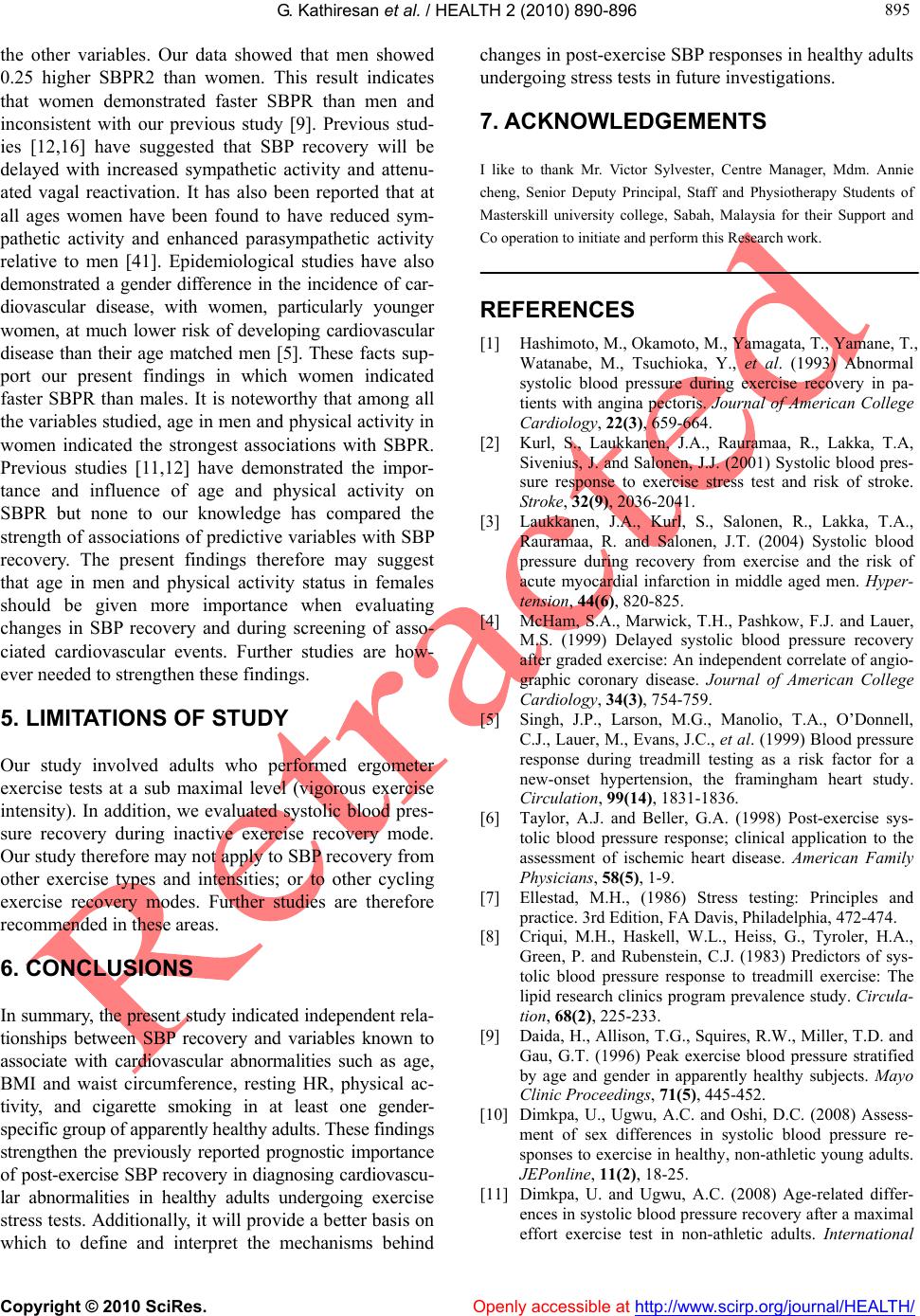 G. Kathiresan et al. / HEALTH 2 (2010) 890-896 Copyright © 2010 SciRes. Openly accessible at http://www.scirp.org/journal/HEALTH/ 895 895 the other variables. Our data showed that men showed 0.25 higher SBPR2 than women. This result indicates that women demonstrated faster SBPR than men and inconsistent with our previous study [9]. Previous stud- ies [12,16] have suggested that SBP recovery will be delayed with increased sympathetic activity and attenu- ated vagal reactivation. It has also been reported that at all ages women have been found to have reduced sym- pathetic activity and enhanced parasympathetic activity relative to men [41]. Epidemiological studies have also demonstrated a gender difference in the incidence of car- diovascular disease, with women, particularly younger women, at much lower risk of developing cardiovascular disease than their age matched men [5]. These facts sup- port our present findings in which women indicated faster SBPR than males. It is noteworthy that among all the variables studied, age in men and physical activity in women indicated the strongest associations with SBPR. Previous studies [11,12] have demonstrated the impor- tance and influence of age and physical activity on SBPR but none to our knowledge has compared the strength of associations of predictive variables with SBP recovery. The present findings therefore may suggest that age in men and physical activity status in females should be given more importance when evaluating changes in SBP recovery and during screening of asso- ciated cardiovascular events. Further studies are how- ever needed to strengthen these findings. 5. LIMITATIONS OF STUDY Our study involved adults who performed ergometer exercise tests at a sub maximal level (vigorous exercise intensity). In addition, we evaluated systolic blood pres- sure recovery during inactive exercise recovery mode. Our study therefore may not apply to SBP recovery from other exercise types and intensities; or to other cycling exercise recovery modes. Further studies are therefore recommended in these areas. 6. CONCLUSIONS In summary, the present study indicated independent rela- tionships between SBP recovery and variables known to associate with cardiovascular abnormalities such as age, BMI and waist circumference, resting HR, physical ac- tivity, and cigarette smoking in at least one gender- specific group of apparently healthy adults. These findings strengthen the previously reported prognostic importance of post-exercise SBP recovery in diagnosing cardiovascu- lar abnormalities in healthy adults undergoing exercise stress tests. Additionally, it will provide a better basis on which to define and interpret the mechanisms behind changes in post-exercise SBP responses in healthy adults undergoing stress tests in future investigations. 7. ACKNOWLEDGEMENTS I like to thank Mr. Victor Sylvester, Centre Manager, Mdm. Annie cheng, Senior Deputy Principal, Staff and Physiotherapy Students of Masterskill university college, Sabah, Malaysia for their Support and Co operation to initiate and perform this Research work. REFERENCES [1] Hashimoto, M., Okamoto, M., Yamagata, T., Yamane, T., Watanabe, M., Tsuchioka, Y., et al. (1993) Abnormal systolic blood pressure during exercise recovery in pa- tients with angina pectoris. Journal of American College Cardiology, 22(3), 659-664. [2] Kurl, S., Laukkanen, J.A., Rauramaa, R., Lakka, T.A, Sivenius, J. and Salonen, J.J. (2001) Systolic blood pres- sure response to exercise stress test and risk of stroke. Stroke, 32(9), 2036-2041. [3] Laukkanen, J.A., Kurl, S., Salonen, R., Lakka, T.A., Rauramaa, R. and Salonen, J.T. (2004) Systolic blood pressure during recovery from exercise and the risk of acute myocardial infarction in middle aged men. Hyper- tension, 44(6), 820-825. [4] McHam, S.A., Marwick, T.H., Pashkow, F.J. and Lauer, M.S. (1999) Delayed systolic blood pressure recovery after graded exercise: An independent correlate of angio- graphic coronary disease. Journal of American College Cardiology, 34(3), 754-759. [5] Singh, J.P., Larson, M.G., Manolio, T.A., O’Donnell, C.J., Lauer, M., Evans, J.C., et al. (1999) Blood pressure response during treadmill testing as a risk factor for a new-onset hypertension, the framingham heart study. Circulation, 99(14), 1831-1836. [6] Taylor, A.J. and Beller, G.A. (1998) Post-exercise sys- tolic blood pressure response; clinical application to the assessment of ischemic heart disease. American Family Physicians, 58(5), 1-9. [7] Ellestad, M.H., (1986) Stress testing: Principles and practice. 3rd Edition, FA Davis, Philadelphia, 472-474. [8] Criqui, M.H., Haskell, W.L., Heiss, G., Tyroler, H.A., Green, P. and Rubenstein, C.J. (1983) Predictors of sys- tolic blood pressure response to treadmill exercise: The lipid research clinics program prevalence study. Circula- tion, 68(2), 225-233. [9] Daida, H., Allison, T.G., Squires, R.W., Miller, T.D. and Gau, G.T. (1996) Peak exercise blood pressure stratified by age and gender in apparently healthy subjects. Mayo Clinic Proceedings, 71(5), 445-452. [10] Dimkpa, U., Ugwu, A.C. and Oshi, D.C. (2008) Assess- ment of sex differences in systolic blood pressure re- sponses to exercise in healthy, non-athletic young adults. JEPonline, 11(2), 18-25. [11] Dimkpa, U. and Ugwu, A.C. (2008) Age-related differ- ences in systolic blood pressure recovery after a maximal effort exercise test in non-athletic adults. International 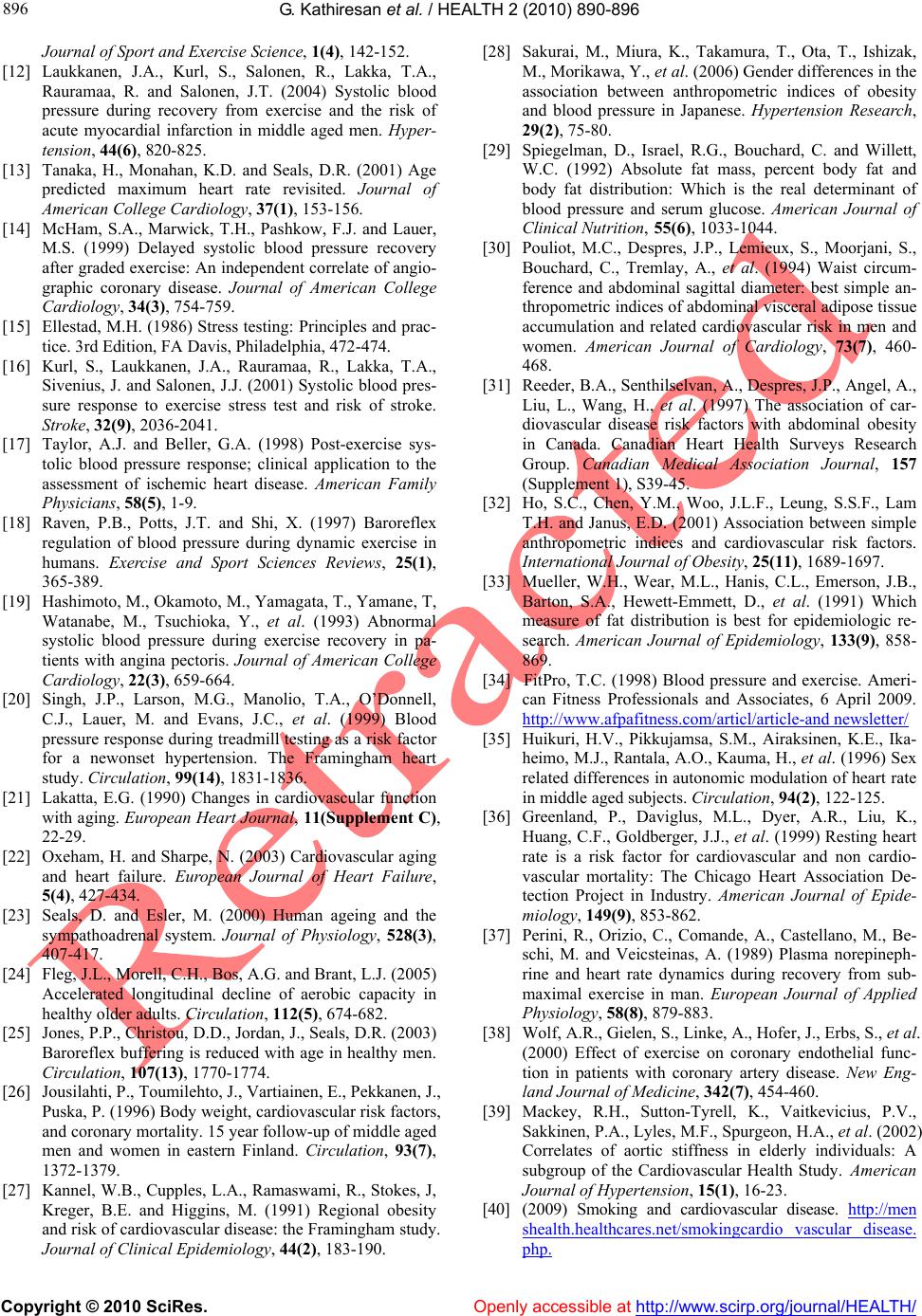 G. Kathiresan et al. / HEALTH 2 (2010) 890-896 Copyright © 2010 SciRes. Openly accessible at http://www.scirp.org/journal/HEALTH/ 896 Journal of Sport and Exercise Science, 1(4), 142-152. [12] Laukkanen, J.A., Kurl, S., Salonen, R., Lakka, T.A., Rauramaa, R. and Salonen, J.T. (2004) Systolic blood pressure during recovery from exercise and the risk of acute myocardial infarction in middle aged men. Hyper- tension, 44(6), 820-825. [13] Tanaka, H., Monahan, K.D. and Seals, D.R. (2001) Age predicted maximum heart rate revisited. Journal of American College Cardiology, 37(1), 153-156. [14] McHam, S.A., Marwick, T.H., Pashkow, F.J. and Lauer, M.S. (1999) Delayed systolic blood pressure recovery after graded exercise: An independent correlate of angio- graphic coronary disease. Journal of American College Cardiology, 34(3), 754-759. [15] Ellestad, M.H. (1986) Stress testing: Principles and prac- tice. 3rd Edition, FA Davis, Philadelphia, 472-474. [16] Kurl, S., Laukkanen, J.A., Rauramaa, R., Lakka, T.A., Sivenius, J. and Salonen, J.J. (2001) Systolic blood pres- sure response to exercise stress test and risk of stroke. Stroke, 32(9), 2036-2041. [17] Taylor, A.J. and Beller, G.A. (1998) Post-exercise sys- tolic blood pressure response; clinical application to the assessment of ischemic heart disease. American Family Physicians, 58(5), 1-9. [18] Raven, P.B., Potts, J.T. and Shi, X. (1997) Baroreflex regulation of blood pressure during dynamic exercise in humans. Exercise and Sport Sciences Reviews, 25(1), 365-389. [19] Hashimoto, M., Okamoto, M., Yamagata, T., Yamane, T, Watanabe, M., Tsuchioka, Y., et al. (1993) Abnormal systolic blood pressure during exercise recovery in pa- tients with angina pectoris. Journal of American College Cardiology, 22(3), 659-664. [20] Singh, J.P., Larson, M.G., Manolio, T.A., O’Donnell, C.J., Lauer, M. and Evans, J.C., et al. (1999) Blood pressure response during treadmill testing as a risk factor for a newonset hypertension. The Framingham heart study. Circulation, 99(14), 1831-1836. [21] Lakatta, E.G. (1990) Changes in cardiovascular function with aging. European Heart Journal, 11(Supplement C), 22-29. [22] Oxeham, H. and Sharpe, N. (2003) Cardiovascular aging and heart failure. European Journal of Heart Failure, 5(4), 427-434. [23] Seals, D. and Esler, M. (2000) Human ageing and the sympathoadrenal system. Journal of Physiology, 528(3), 407-417. [24] Fleg, J.L., Morell, C.H., Bos, A.G. and Brant, L.J. (2005) Accelerated longitudinal decline of aerobic capacity in healthy older adults. Circulation, 112(5), 674-682. [25] Jones, P.P., Christou, D.D., Jordan, J., Seals, D.R. (2003) Baroreflex buffering is reduced with age in healthy men. Circulation, 107(13), 1770-1774. [26] Jousilahti, P., Toumilehto, J., Vartiainen, E., Pekkanen, J., Puska, P. (1996) Body weight, cardiovascular risk factors, and coronary mortality. 15 year follow-up of middle aged men and women in eastern Finland. Circulation, 93(7), 1372-1379. [27] Kannel, W.B., Cupples, L.A., Ramaswami, R., Stokes, J, Kreger, B.E. and Higgins, M. (1991) Regional obesity and risk of cardiovascular disease: the Framingham study. Journal of Clinical Epidemiology, 44(2), 183-190. [28] Sakurai, M., Miura, K., Takamura, T., Ota, T., Ishizak, M., Morikawa, Y., et al. (2006) Gender differences in the association between anthropometric indices of obesity and blood pressure in Japanese. Hypertension Research, 29(2), 75-80. [29] Spiegelman, D., Israel, R.G., Bouchard, C. and Willett, W.C. (1992) Absolute fat mass, percent body fat and body fat distribution: Which is the real determinant of blood pressure and serum glucose. American Journal of Clinical Nutrition, 55(6), 1033-1044. [30] Pouliot, M.C., Despres, J.P., Lemieux, S., Moorjani, S., Bouchard, C., Tremlay, A., et al. (1994) Waist circum- ference and abdominal sagittal diameter: best simple an- thropometric indices of abdominal visceral adipose tissue accumulation and related cardiovascular risk in men and women. American Journal of Cardiology, 73(7), 460- 468. [31] Reeder, B.A., Senthilselvan, A., Despres, J.P., Angel, A., Liu, L., Wang, H., et al. (1997) The association of car- diovascular disease risk factors with abdominal obesity in Canada. Canadian Heart Health Surveys Research Group. Canadian Medical Association Journal, 157 (Supplement 1), S39-45. [32] Ho, S.C., Chen, Y.M., Woo, J.L.F., Leung, S.S.F., Lam T.H. and Janus, E.D. (2001) Association between simple anthropometric indices and cardiovascular risk factors. International Journal of Obesity, 25(11), 1689-1697. [33] Mueller, W.H., Wear, M.L., Hanis, C.L., Emerson, J.B., Barton, S.A., Hewett-Emmett, D., et al. (1991) Which measure of fat distribution is best for epidemiologic re- search. American Journal of Epidemiology, 133(9), 858- 869. [34] FitPro, T.C. (1998) Blood pressure and exercise. Ameri- can Fitness Professionals and Associates, 6 April 2009. http://www.afpafitness.com/articl/article-and newsletter/ [35] Huikuri, H.V., Pikkujamsa, S.M., Airaksinen, K.E., Ika- heimo, M.J., Rantala, A.O., Kauma, H., et al. (1996) Sex related differences in autonomic modulation of heart rate in middle aged subjects. Circulation, 94(2), 122-125. [36] Greenland, P., Daviglus, M.L., Dyer, A.R., Liu, K., Huang, C.F., Goldberger, J.J., et al. (1999) Resting heart rate is a risk factor for cardiovascular and non cardio- vascular mortality: The Chicago Heart Association De- tection Project in Industry. American Journal of Epide- miology, 149(9), 853-862. [37] Perini, R., Orizio, C., Comande, A., Castellano, M., Be- schi, M. and Veicsteinas, A. (1989) Plasma norepineph- rine and heart rate dynamics during recovery from sub- maximal exercise in man. European Journal of Applied Physiology, 58(8), 879-883. [38] Wolf, A.R., Gielen, S., Linke, A., Hofer, J., Erbs, S., et al. (2000) Effect of exercise on coronary endothelial func- tion in patients with coronary artery disease. New Eng- land Journal of Medicine, 342(7), 454-460. [39] Mackey, R.H., Sutton-Tyrell, K., Vaitkevicius, P.V., Sakkinen, P.A., Lyles, M.F., Spurgeon, H.A., et al. (2002) Correlates of aortic stiffness in elderly individuals: A subgroup of the Cardiovascular Health Study. American Journal of Hypertension, 15(1), 16-23. [40] (2009) Smoking and cardiovascular disease. http://men shealth.healthcares.net/smokingcardio vascular disease. php. 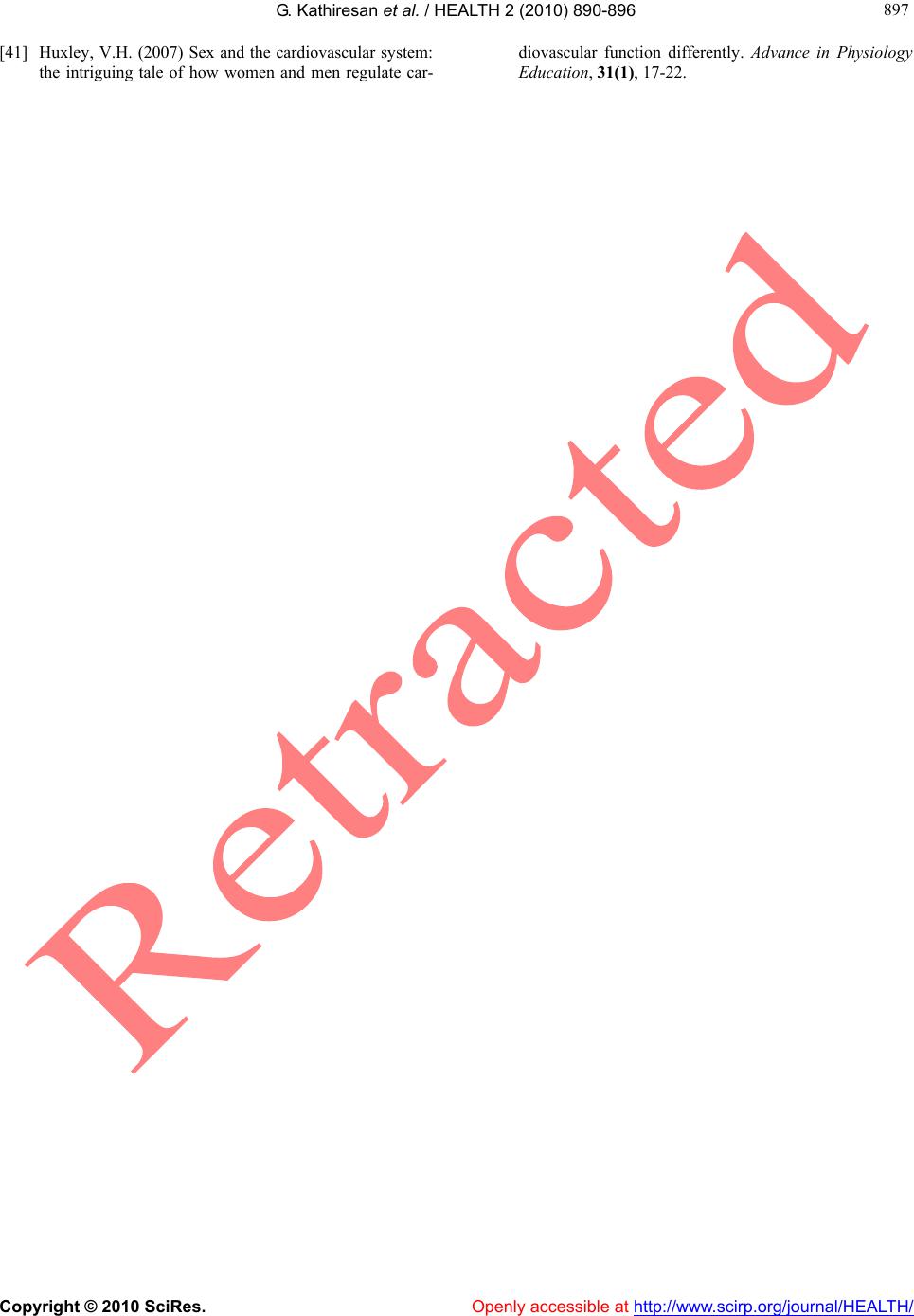 G. Kathiresan et al. / HEALTH 2 (2010) 890-896 Copyright © 2010 SciRes. http://www.scirp.org/journal/HEALTH/Openly accessible at 897 897 [41] Huxley, V.H. (2007) Sex and the cardiovascular system: the intriguing tale of how women and men regulate car- diovascular function differently. Advance in Physiology Education, 31(1), 17-22.
|